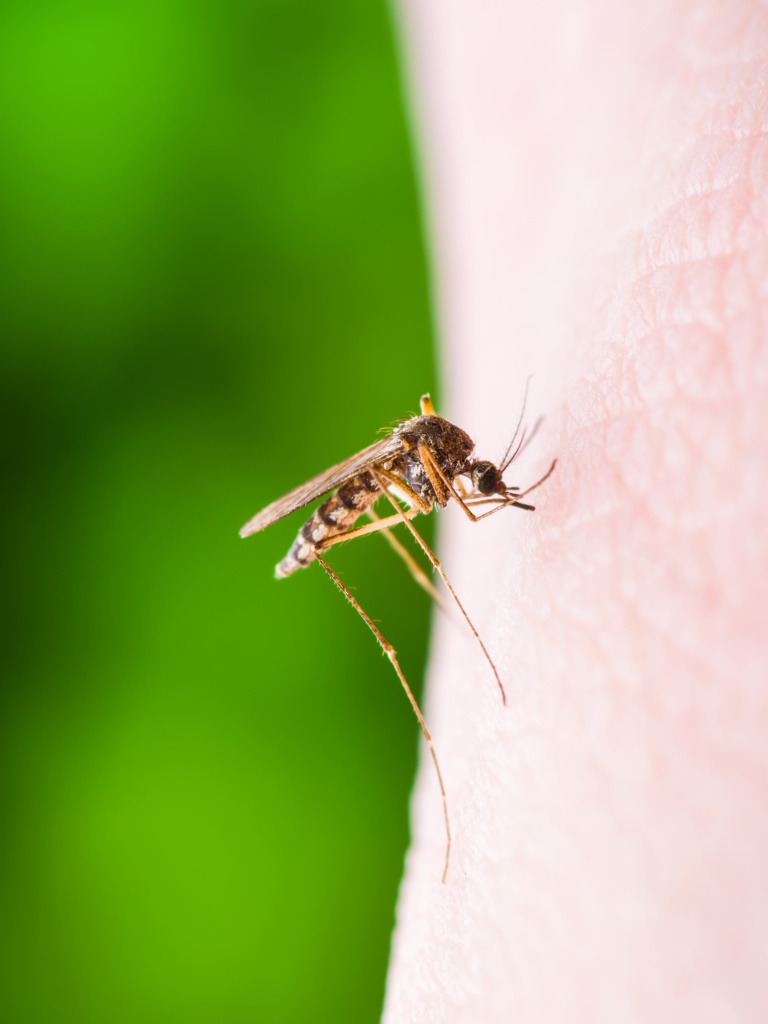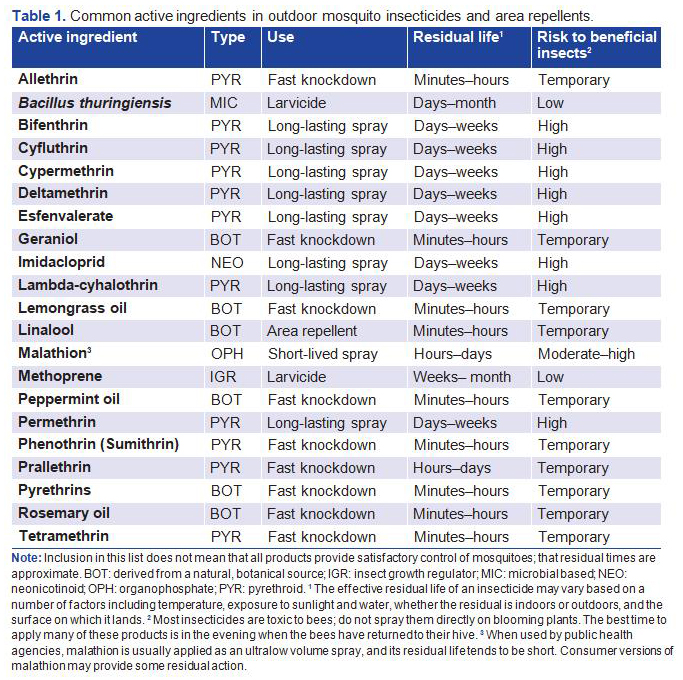Do-It-Yourself Backyard Mosquito Control
Article By | Mike Merchant1, Sonja Swiger1, and Steve Presley2
Concerns about mosquito-borne disease this summer are prompting many of us to learn what to do to reduce the chances of mosquito bites in our own backyards and gardens. Fortunately, there are good ways to manage mosquitoes around your home at reasonable cost.
Destroy or treat mosquito breeding sites
The first step in any mosquito control effort is to find and eliminate the mosquito breeding sites from your backyard. The most common biting mosquitoes in Texas, and the ones most likely to carry Zika virus, are not strong fliers. The yellow fever mosquito (Aedes aegypti) and the Asian tiger mosquito (Aedes albopictus) both tend to live and bite within 200 to 300 yards of their breeding sites.
Mosquitoes breed in standing water, especially if it stands for at least 7 days. Adult mosquitoes lay their eggs near the standing water, and their young (larvae) develop in the water before emerging to bite. Because these mosquito larvae feed on bacteria and other microorganisms, the water must be stagnant and contain some organic matter such as leaves, soil, bird droppings, or grass clippings.
For this reason, mosquitoes usually do not breed in running streams or maintained swimming pools; however, birdbaths, old tires, and clogged gutters make excellent mosquito breeding sites.
You can destroy many breeding sites by draining, dumping, or filling them. Dump water from buckets, flowerpot dishes, tarps, and wheelbarrows. If possible, turn over or cover them so they can’t catch more water. Fill holes or low areas with sand or gravel and seal tree holes (Fig. 1) with expanding foam.

If you find standing water that cannot be easily dumped, filled, or drained, treat it with an approved mosquito insecticide (larvicide):
- Bacillus thuringiensis israeliensis (Bti) is made from bacteria that kill mosquito larvae. A small amount, in the form of compressed donuts (Fig. 2), briquettes, or granules, is effective for up to 30
- Methoprene is an insect growth regulator applied to water as a granule or briquette. Depending on the formulation, it may last for more than 30 days.

Products containing these insecticides are sold online and in many hardware stores and garden centers.
Advantages: Without breeding sites, no mosquito larvae can grow up to be adults and bite you. These products are safe to use and apply around pets. They are toxic only to aquatic insects and do not hurt fish or birds.
Limitations: You must know where the mosquitoes are breeding and you must reapply these products throughout the mosquito season.
Use backyard foggers
For temporary relief from biting mosquitoes—such as for a backyard barbecue or another special event— your best choice may be a fogger.
Mosquitoes hide in plants or other shady sites after they leave their breeding sites and take a blood meal. Direct the fog there to kill these resting adult
mosquitoes. Although fogger chemicals do not control mosquitoes long term, they can suppress them for several hours or more.
Mosquito foggers generate very small particles of floating insecticide that drifts through leaves and kill adult mosquitoes through direct contact. Thermal foggers use heat, usually from a propane flame, to create a thick white fog that can kill many resting mosquitoes.
Advantages: Foggers can suppress mosquitoes
overnight and sometimes the following day(s). They are easy to use and apply.

Limitations: Because they do not control mosquitoes for long, foggers are best used just before an outdoor event.
Thermal foggers (Fig. 3) produce a highly visible smoke that can alarm neighbors. Some people mistake it for smoke from a real fire and call the fire department.
Aerosol foggers empty quickly and cost more than thermal foggers.
Both types of foggers may harm beneficial insects, such as bees, butterflies, and predator insects. Do not use them near plants where bees are active, and follow the label instructions carefully.
Apply backyard residual sprays
Residual sprays (sprays that stay for extended times on surfaces) can suppress mosquito activity for up to a month. They are applied to mosquito resting sites on the sides of homes, around doorways, in tall grass and shrubs, and even in backyard trees.
Residual spray applications can be made by professional applicators, or by you at home using aerosol sprays, pump-type garden-sprayers or hose end-sprayers.
Professional applicators (Fig. 4) typically use backpack units that blow a fine mist several yards up in the air and through dense foliage. The powerful fans in mist blowers can penetrate plants and tree canopies well.

Longer lasting aerosol sprays are also available through hardware and garden supply stores. These sprays penetrate foliage but tend to settle more quickly than do sprays applied with mist blowers. They do not produce smoke and do not penetrate as well, or travel as far, as thermal foggers. A variety of residual insecticides are available in aerosol form, including cyfluthrin, deltamethrin, lambda-cyhalothrin and others.
Residual sprays can also be applied with simple hand-held pump sprayers or using ready-to-use insecticide bottles designed to attach to the end of a garden hose. It is more difficult with these applicators to get sprays to the undersides of leaves, or within deep foliage compared to mist blower equipment.
Nevertheless, even do-it-yourself sprays around the backyard can help reduce the numbers of biting mosquitoes for days after application.
Advantages: Residual sprays provide extended relief from biting mosquitoes without having to spray repeatedly. Drift of spray from aerosols or pump sprayers is generally less than from thermal fog, so they can be applied more precisely. Spraying around doorways can reduce the risk of mosquitoes entering the home. Hose-end and pump garden sprayers are inexpensive and easily purchased at most garden centers.
Disadvantages: Professional applications cost more
than DIY treatments but can be more effective. They can also kill beneficial organisms such as butterflies, pollinators, and predatory insects. To minimize the harm to beneficial insects, spray in the evening, and avoid blooming plants. Using these chemicals repeatedly can cause some mosquitoes to develop resistance to these insecticides.
Other backyard control options
Mosquito traps (Fig. 5) often use carbon dioxide or human scent attractants to draw in and trap or kill mosquitoes. To work, they must be at least as attractive as a human and operate continuously when mosquitoes are active. Some of these traps
are relatively expensive and effectiveness may vary depending on wind and airflow patterns.
Bug zappers use an ultraviolet light source to attract mosquitoes to an electrocuting grid; unfortunately, these traps attract and kill many
beneficial insects and do not control the females of biting species.
Ovitraps are artificial breeding containers that sterilize or kill mosquitoes that come to the traps to lay eggs. Although some ovitraps can control some mosquito species, such as Asian tiger mosquitoes, few are available on the retail market, and those have not yet been thoroughly tested.

Attract-and-kill sprays mix sugar water with a toxicant. The sugary mix attracts adult female mosquitoes, and the chemical kills them. Although the products now being sold have not been well tested, the attract-and-kill concept shows some promise.
Backyard mister systems consist of a timer connected to a series of nozzles that disperse a fine mist, or fog, of insecticide throughout the yard. These systems are expensive and controversial. Continual use of these systems may contribute to creating insecticide- resistant mosquitoes. Daytime use of mister systems is also likely to harm beneficial insects.
Know your product’s active ingredients
When choosing a pesticide to control mosquitoes, you first need to know the active ingredient. Look for the “Active Ingredient” statement on the front of the pesticide label, usually near the bottom of the label. This will allow you to compare to the list of active ingredients (Table 1) for outdoor mosquito control.
The information given herein is for educational purposes only. Reference to commercial products or trade names is made with the understanding that no discrimination is intended and no endorsement by the Texas A&M AgriLife Extension Service is implied.
Texas A&M AgriLife Extension Service | AgriLifeExtension.tamu.edu
More Extension publications can be found at AgriLifeBookstore.org
The Texas A&M AgriLife Extension Service provides equal access in its programs, activities, education, and employment, without regard to race, color, sex, religion, national origin, disability, age, genetic information, veteran status, sexual orientation, or gender identity.
The Texas A&M University System, U.S. Department of Agriculture, and the County Commissioners Courts of Texas Cooperating.

1Extension entomologist, Texas A&M AgriLife Extension Service, The Texas A&M University System
2Professor of Environmental Toxicology, Texas Tech University

